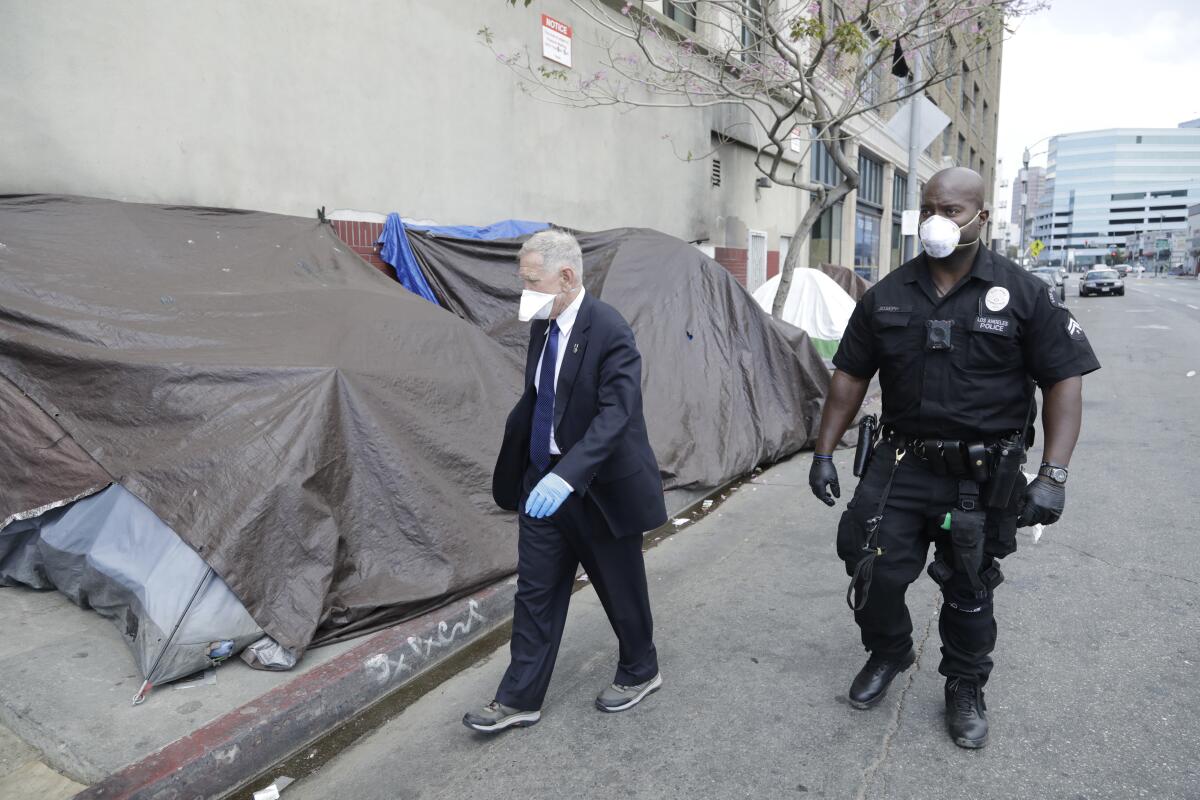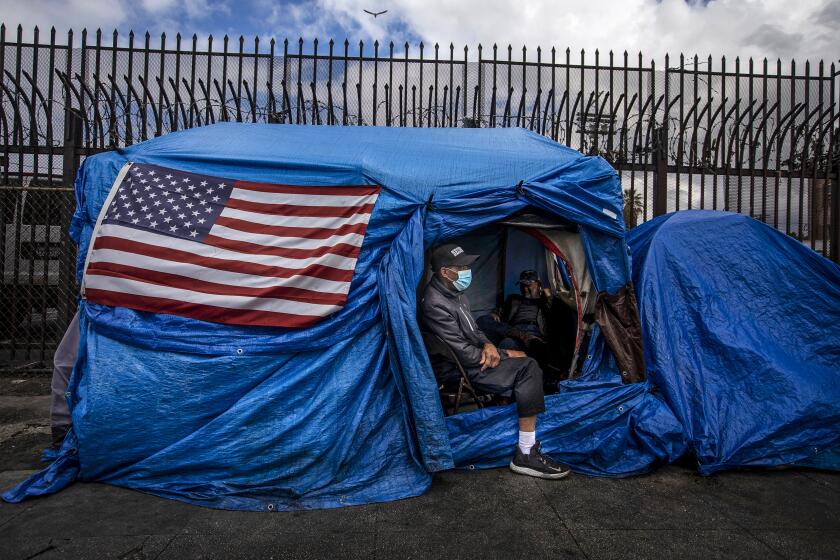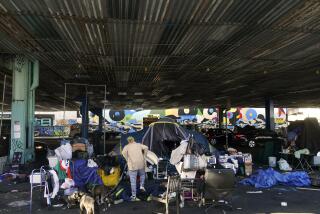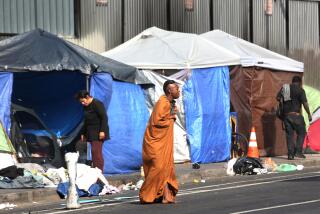Judge orders L.A. city and county to offer shelter to everyone on skid row by fall

A federal judge overseeing a sprawling lawsuit about homelessness in Los Angeles ordered the city and county Tuesday to offer some form of shelter or housing to the entire homeless population of skid row by October.
Judge David O. Carter granted a preliminary injunction sought by the plaintiffs in the case last week and now is telling the city and county that they must offer single women and unaccompanied children on skid row a place to stay within 90 days, help families within 120 days and finally, by Oct. 18, offer every homeless person on skid row housing or shelter.
It’s unclear whether the city and county will challenge the order, which also calls for the city to put $1 billion into an escrow account — an idea that has raised concerns among city officials.
The ruling argues that L.A. city and county wrongly focused on permanent housing at the expense of more temporary shelter, “knowing that massive development delays were likely while people died in the streets.” That element of the order underscores the judge’s skepticism of a core part of L.A.’s current strategy to tackle homelessness.
“Los Angeles has lost its parks, beaches, schools, sidewalks, and highway systems due to the inaction of city and county officials who have left our homeless citizens with no other place to turn,” Carter wrote in a 110-page brief sprinkled with quotes from Abraham Lincoln and an extensive history of how skid row was first created.
“All of the rhetoric, promises, plans, and budgeting cannot obscure the shameful reality of this crisis — that year after year, there are more homeless Angelenos, and year after year, more homeless Angelenos die on the streets.” Last year more than 1,300 homeless people died in Los Angeles County.
In the last homeless count in January 2020, more than 4,600 unhoused people were found to be living on skid row — about 2,500 in large shelters and 2,093 on the streets. They account for only slightly more than 10% of the city’s overall homeless population, and it’s not clear what Carter’s order might mean for other parts of the city.
The judge wrote that “after adequate shelter is offered,” he would allow the city to enforce laws that keep streets and sidewalks clear of tents so long as they’re consistent with previous legal rulings that have limited the enforcement of such rules. That appears to only apply to skid row.
He also ordered the county to offer “support services to all homeless residents who accept the offer of housing” including placements in “appropriate emergency, interim, or permanent housing and treatment services.” The costs would be split by the city and county, he said.
Rob Wilcox, a spokesman for the city attorney’s office, said Tuesday that city lawyers are reviewing the order. He declined to comment further.
Skip Miller, partner at the Miller Barondess law firm, which is outside counsel for the county in the lawsuit, said the county is “now evaluating our options, including the possibility of an appeal.”
Previously, the county had asked to be removed from the case, arguing that it was about the city and that the county was aggressively responding to homelessness without any direction from the court. It cited efforts that included spending hundreds of millions of dollars annually through the Measure H sales tax and developing innovative strategies such as Project Roomkey in response to the COVID-19 pandemic. Project Roomkey is a state program that provides temporary funding for cities and counties to rent hotel rooms for homeless people during the pandemic.
The push for an injunction “is an attempt by property owners and businesses to rid their neighborhood of homeless people,” Miller said.
The mayor’s proposed budget, set for release Tuesday, comes at a moment of heightened frustration over the city’s handling of homelessness.
“There is no legal basis for an injunction because the county is spending hundreds of millions of dollars a year on proven strategies,” he added.
Matthew Umhofer, an attorney representing the plaintiffs, the L.A. Alliance for Human Rights, said he and his clients were ecstatic. Carter’s call for action was what they had been looking for when they filed the case, he said, and why they sought out Carter, who had overseen similar cases in Orange County in recent years, to preside over it.
“This is exactly the kind of aggressive emergency action that we think is necessary on the issue of homelessness in Los Angeles,” Umhofer said.
The Alliance is a coalition of downtown business owners and residents that filed the case in March 2020, accusing the city and county of breaching their duty to abate a nuisance, reducing property value without compensation, wasting public funds and violating the state environmental act and state and federal acts protecting people with disabilities.
Carter’s order came the day that Mayor Eric Garcetti released his budget for the next fiscal year, which includes nearly $1 billion in spending on homelessness. The longtime federal judge also ordered “that $1 billion, as represented by Mayor Garcetti, will be placed in escrow forthwith.”
Of the $1 billion in homeless spending planned by Garcetti, more than a third would come from Proposition HHH, the 2016 bond measure to build permanent housing for homeless residents. Garcetti aides said they expect the city will be building or developing 89 HHH projects over the next fiscal year, for a total of 5,651 housing units.
Whether Carter’s order will disrupt those activities is unclear. In his order, the judge said he wants a report in 90 days of every developer receiving funds from HHH, as well as new regulations to “limit the possibility of funds being wasted.”
At a press conference Tuesday afternoon, Garcetti declined to say whether the city would file an appeal of the order, saying he first wants to read it. But he suggested that Carter’s order could slow down the construction of HHH projects.
“Roadblocks masquerading as progress are the last things we need,” he said.
Clear homeless people from skid row by October? This is a judge’s bold order for L.A.
Because the $1 billion for homelessness doesn’t yet exist — some of it hasn’t arrived from Washington and none of it has been approved by the City Council for the coming year — Garcetti said he also fears the city will be asked instead to put some other source of money in the escrow account.
Carter has also asked for a number of reports from city and county officials about how money for combating homelessness has been and is currently being spent. He has also ordered that the city and county cease any sales or transfers of city or county property before such reports are provided.
The lengthy ruling also skewered corruption scandals involving housing projects, “excessive delays and skyrocketing costs” under the HHH bond measure, and L.A.’s failure to seek federal reimbursement for Project Roomkey rooms.
Councilman Kevin de León, whose district includes skid row, welcomed the judge’s decision. Although L.A. needs more clarity about setting aside $1 billion, he said, the tight timeframe to offer shelter or housing to skid row residents “lights a fire under the city to act with a real sense of urgency and to match the rhetoric with real outcomes to save lives.”
“It’s a strong shot across the bow — and he is expecting action,” de León said. “Not continued negotiations or studying everything to death.”
Pete White, executive director of the skid row-based Los Angeles Community Action Network, which is an intervenor in the case, said his organization had “grown concerned that politicians are using this litigation to justify investment in emergency shelters instead of housing.”
“We all know that shelters won’t solve our housing crisis, and they definitely won’t address the structural racism that got us here in the first place.”
Skid row activist and resident Jeff Page echoed White , saying the tight window for moving people means they won’t be going to permanent housing but instead to “dorm style living that in and of itself is problematic.” What’s needed, he said, is more permanent housing in the neighborhood to be built as quickly as possible.
“We need more housing here. We need more services,” he said.
In his order, Carter outlined historic forms of discrimination that had cut Black people out of housing opportunities, including redlining, segregated systems of assistance during the Great Depression, highway construction that displaced Black families, and criminalization that has disproportionately affected Black communities.
Racial inequity has continued to color government handling of the crisis, Carter concluded, opining that current city and county policies “compound and perpetuate structural racism, threatening the integrity of Black families in Los Angeles and forcing a disproportionate number of Black families to go unhoused.”
The judge has previously compared the situation to the aftermath of the seminal civil rights case Brown vs. Board of Education, saying there are times when the federal judiciary may need to act “after a long period of inaction by local government officials.”
Laurie Levenson, a professor at Loyola Law School, called the 110-page order a “deep dive into the problems of homelessness in Los Angeles and an expression of Carter’s frustration with how the city and county have responded to this crisis.” She noted that judges in the South during the 1950s and 1960s had used similarly expansive injunctions to make desegregation a reality and in other cases to implement prison reform.
She wasn’t sure how a higher court might rule if this case ends up getting appealed but said it was “certainly a landmark decision.”
“It is an open question whether the appellate court will step in,” she said. “As Judge Carter acknowledges, there is usually a hearing before such an order. However, he has loaded up his decision with facts that he says obviate the need for a hearing. The judge has made a bold move.”
News of the injunction had not trickled down to the streets of skid row Tuesday, but people reacted favorably when informed of it. Hasan Saleem, 58, who was sitting outside his tent on 6th Street, said he would take housing “right away” if offered, even if it takes 180 days. Still, he remained skeptical.
“I wouldn’t mind waiting if it was true,” he said. “I don’t know if it’s true or not.”
“It’s better than how they used to do it when they just take your stuff and put you to jail,” said Peaceful Bolden, who was standing with a small group across the street from the Los Angeles Mission. “At least they’re trying.”
But Bolden said she did not think housing alone would be enough.
“Some of these people are just refugees from whatever life they used to have,” she said. “They need mental health. They need hospice, some of them. A lot of them don’t want to leave because they don’t want to be under anyone’s rules.”
Andy Bales, president and CEO of the Union Rescue Mission, had heard the news and hailed it as the “wall of reality” that the city and county are finally running into.
“It’s what I came to Union Rescue Mission to accomplish,” Bales said. “I’ve always wanted to decentralize skid row and regionalize Services throughout the County. My hope is this will do that.”
Times staff writers David Zahniser and Dakota Smith contributed to this report.
More to Read
Sign up for Essential California
The most important California stories and recommendations in your inbox every morning.
You may occasionally receive promotional content from the Los Angeles Times.










